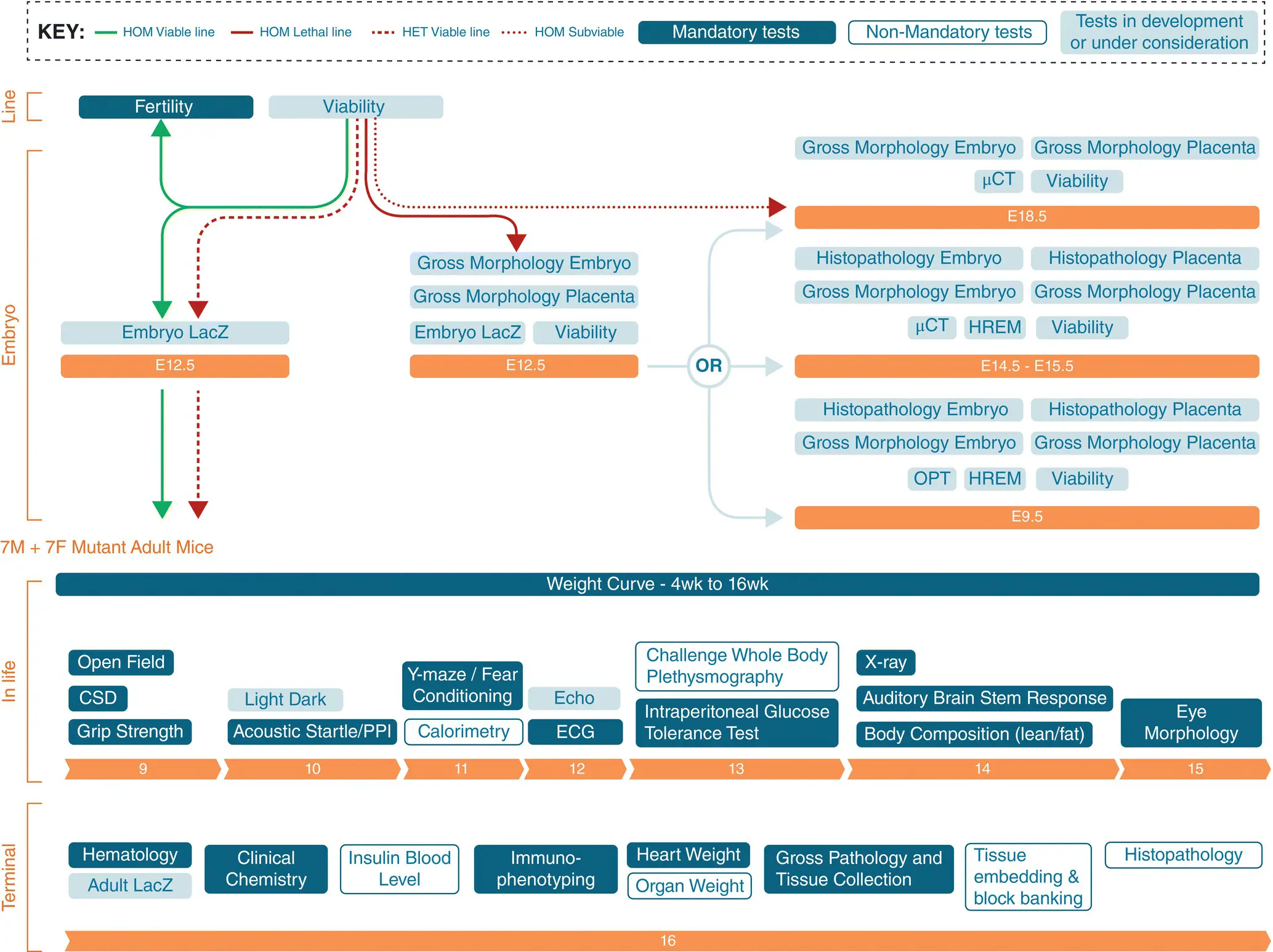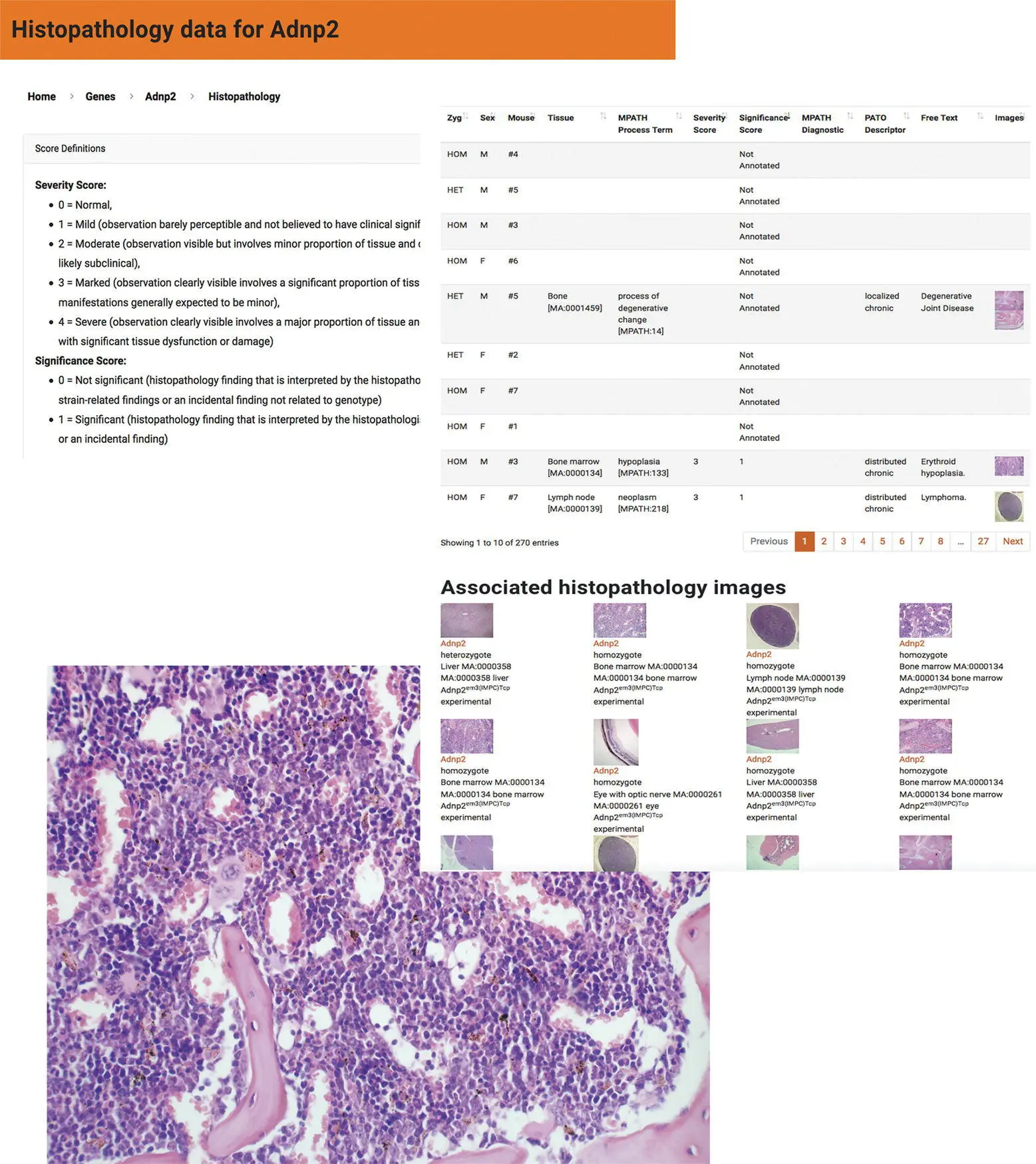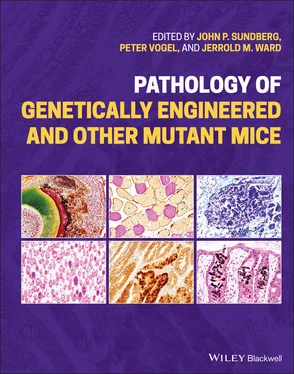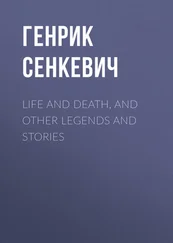Pathology of Genetically Engineered and Other Mutant Mice
Здесь есть возможность читать онлайн «Pathology of Genetically Engineered and Other Mutant Mice» — ознакомительный отрывок электронной книги совершенно бесплатно, а после прочтения отрывка купить полную версию. В некоторых случаях можно слушать аудио, скачать через торрент в формате fb2 и присутствует краткое содержание. Жанр: unrecognised, на английском языке. Описание произведения, (предисловие) а так же отзывы посетителей доступны на портале библиотеки ЛибКат.
- Название:Pathology of Genetically Engineered and Other Mutant Mice
- Автор:
- Жанр:
- Год:неизвестен
- ISBN:нет данных
- Рейтинг книги:3 / 5. Голосов: 1
-
Избранное:Добавить в избранное
- Отзывы:
-
Ваша оценка:
- 60
- 1
- 2
- 3
- 4
- 5
Pathology of Genetically Engineered and Other Mutant Mice: краткое содержание, описание и аннотация
Предлагаем к чтению аннотацию, описание, краткое содержание или предисловие (зависит от того, что написал сам автор книги «Pathology of Genetically Engineered and Other Mutant Mice»). Если вы не нашли необходимую информацию о книге — напишите в комментариях, мы постараемся отыскать её.
An updated and comprehensive reference to pathology in every organ system in genetically modified mice Pathology of Genetically Engineered and Other Mutant Mice
Pathology of Genetically Engineered and Other Mutant Mice
Pathology of Genetically Engineered and Other Mutant Mice — читать онлайн ознакомительный отрывок
Ниже представлен текст книги, разбитый по страницам. Система сохранения места последней прочитанной страницы, позволяет с удобством читать онлайн бесплатно книгу «Pathology of Genetically Engineered and Other Mutant Mice», без необходимости каждый раз заново искать на чём Вы остановились. Поставьте закладку, и сможете в любой момент перейти на страницу, на которой закончили чтение.
Интервал:
Закладка:

Figure 2.3 IMPC phenotyping pipelines for adult mice (17 weeks) and embryos.

Figure 2.4 The histopathology browser for the IMPC database. Data can be searched for by gene and, where phenotyping of the strain has been completed, users can find data from individual mice, with zygosity of the knockout and in many cases, a diagnostic assessment with lesion and anatomical location derived from the MPATH and MA ontologies and used combinatorially. There are also estimates of severity and microanatomical qualifiers. The use of the ontologies in this way is described in Elmore et al. [49]. Selected hematoxylin and eosin stained images are available.
Background Strain Comparison Studies
Mouse Phenome Database ( https://phenome.jax.org)
The Mouse Phenome Database (MPD) was originally envisioned as a site to host data on comparative studies that utilized multiple inbred strains. It provided a repository for the primary data. As the site evolved, the data could be manipulated to generate a variety of tables to define quantitative differences for specific phenotypes between strains. Today, the site has been refined enabling integration of genomic and phenomic data by providing access to primary experimental data, well‐documented data collection protocols, and a variety of tools to analyze these datasets. Investigators worldwide provided the data on this site which represent a broad scope of disease‐related characteristics in the inbred mouse strains to variations in behavior, morphological, and physiological differences in naive mice and those exposed to drugs, environmental agents, or other manipulations [56].
Mouse Pathology Image (Histopathology) Resources
Pathbase, the European Mouse Pathology Database ( http://www.pathbase.net)
Pathbase is a community resource for images of all types of lesions and normal tissues from laboratory mice [57, 58]. Pathologists from all over the world, not just Europe, provide photomicrographs of lesions diagnosed in laboratory mice. While initially the goal was to illustrate lesions in genetically engineered mice, this website has evolved to include all types of mouse diseases as well as normal tissues including large collections of images from aged inbred mouse strain studies [33]. These data are curated in an ontology built around the Mouse Anatomy (MA) [59] and Mouse Pathology (MPATH) [60] ontologies, with more refinement for selected organs, such as skin [61]. This enables rapid retrieval of histologic images. In fact, if one integrates this into a diagnostic database, one can use the diagnostic term to go to Pathbase to look up the definition of the term and then access images of lesions with that diagnosis provided by numerous pathologists from around the world, something called the “virtual second opinion” [62]. Integration of the Mouse Anatomy and Pathology Ontologies into diagnostic laboratory software sets up a controlled vocabulary that enables consistent data searches to enable high‐level computational analysis of the dataset [62, 63].
National Toxicology Program Neoplastic Lesion Atlas ( https://ntp.niehs.nih.gov/nnl/index.htm)
The National Toxicology Program Atlas of Nonneoplastic Lesions in Rats and Mice is a publicly accessible resource built around the goal of identifying potential human carcinogens in rodent bioassays. Nonneoplastic diseases are also a major cause of morbidity and mortality in humans. This atlas provides diagnostic guidelines for histologic lesions in both rats and mice. This was built around an effort to maintain consistency with lesion terminology through the creation of the International Harmonization of Nomenclature and Diagnostic Criteria (INHAND) monograph series [64, 65] and classification systems in textbooks [66, 67]. A web resource for INHAND can be found on https://www.toxpath.org/inhand.asp.
The database is organized by major organ systems (alimentary, cardiovascular, endocrine, hematopoietic, hepatobiliary, immune, integumentary, musculoskeletal, nervous, reproductive [female and male], respiratory, special senses, and urinary) and within each category are a limited number of examples of lesions with a representative image. This is useful for getting started to gain a basic understanding of lesions, terms, and definitions. Unfortunately, while aimed at standardizing toxicology diagnoses, it does not embrace the complexity of human disease making it relatively superficial and not helpful to define a mouse model for a human disease.
Noah's Arkive, Charles Louis Davis, and Samuel Wesley Thompson Foundation for the Advancement of Veterinary and Comparative Pathology ( http://noahsarkive.cldavis.org/cgi‐bin/show_image_info_page.cgi)
Noah's Arkive was developed in the early 1980s as The International Veterinary Pathology Slide Bank to serve as a repository of slides (2 × 2 color transparencies) contributed by individuals and institutions worldwide. In 1986, this slide archive was made available in a digitized format, on laser videodisks. In 2010, Noah's Arkive was launched as a single web‐based resource. Images cover a broad variety of species not just laboratory mice. As such, it is a powerful resource for comparing lesions between species when working up a new mouse model. When looking up lists of images (7 February 2020), searching just for mouse, there were 141 pages with 100 entries (often with more than one image per entry) per page listed.
Organ/Disease Specific Resources
Most websites are generic providing examples of lesions or models that cover a broad range of topics and organ systems. However, most investigators focus on a particular disease or group of diseases or specific anatomic sites. Several organ/disease specific websites are listed below that remain active and are maintained at the time of this writing. These sites come and go so one is best advised to do a search under the disease or organ of interest. Many of the disease sites one finds are for patient advocacy groups (foundations) that often provide both patient information and sometimes a review or relevant research that may involve mouse models. While a useful source of information for experts in the field, these resources do not often provide detail on non‐human animal models as they are aimed more at support of the clinical practice and medical research communities. Other sites have been developed by investigators working with specific models or fine‐tuning discoveries in the many large‐scale mutant producing programs. Several are provided below.
Bone Diseases: Skeletal Phenotyping of IMPC/KOMP Mice ( http://www.bonebase.org)
The Knockout Mouse Program (KOMP) is a United States initiative in collaboration with the International Knockout Mouse Consortium (IKMC) to generate a large number of laboratory mice with a single gene inactivated (null mouse) eventually for all protein coding genes, one at a time. A collaboration between investigators at several institutions have been systematically analyzing bones in C57BL/6NJ mice generated by KOMP. This is not one of the primary sites generating and phenotyping these mutant mice, but rather a group specializing in detailed analysis of subtle abnormalities only of bones. The group is focused on screening gene knockout mice for variation in bone mass using μCT and histomorphometry to systematically analyze mice generated from the various KOMP primary sites [68].
Читать дальшеИнтервал:
Закладка:
Похожие книги на «Pathology of Genetically Engineered and Other Mutant Mice»
Представляем Вашему вниманию похожие книги на «Pathology of Genetically Engineered and Other Mutant Mice» списком для выбора. Мы отобрали схожую по названию и смыслу литературу в надежде предоставить читателям больше вариантов отыскать новые, интересные, ещё непрочитанные произведения.
Обсуждение, отзывы о книге «Pathology of Genetically Engineered and Other Mutant Mice» и просто собственные мнения читателей. Оставьте ваши комментарии, напишите, что Вы думаете о произведении, его смысле или главных героях. Укажите что конкретно понравилось, а что нет, и почему Вы так считаете.












